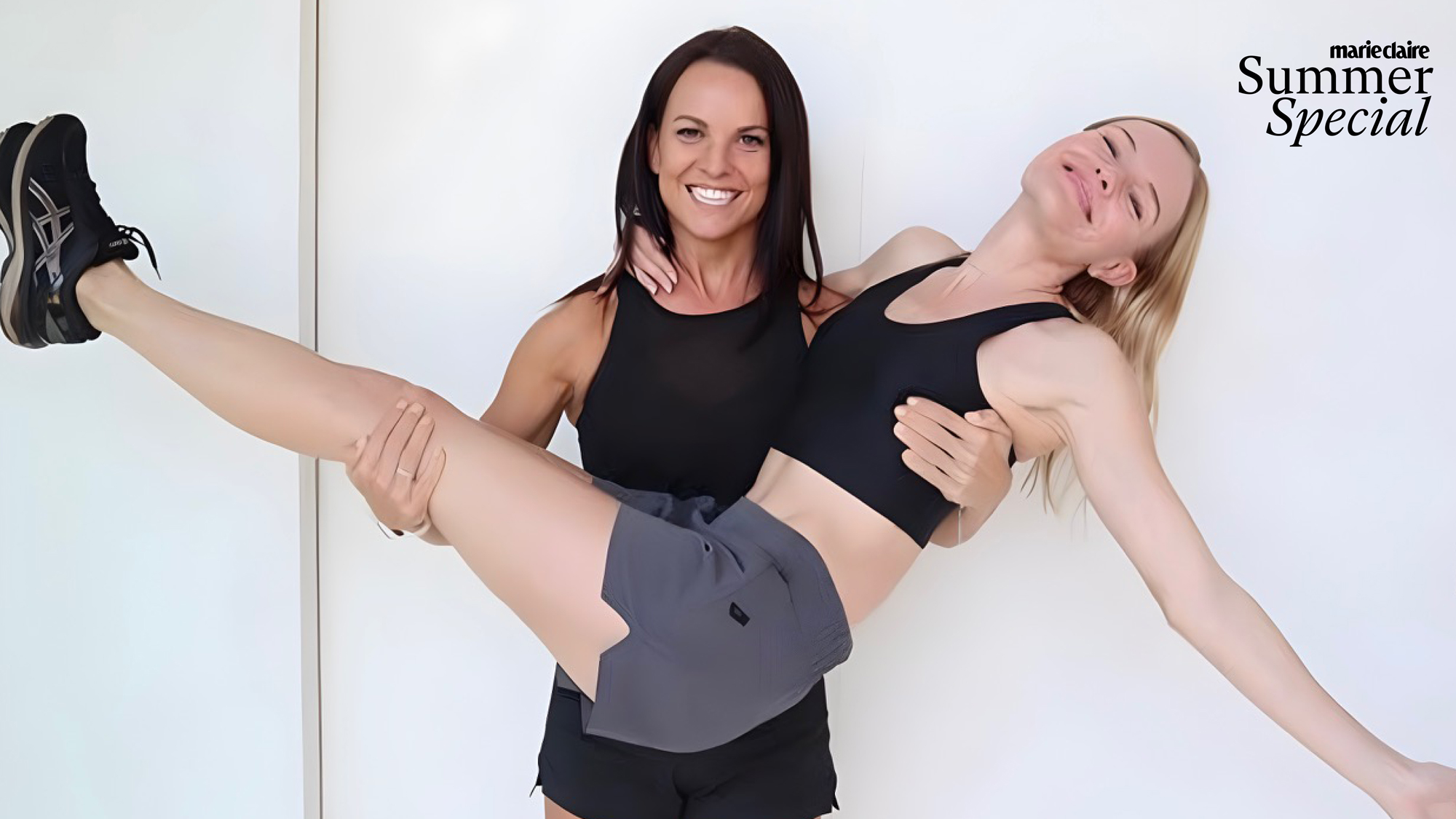Kate Bosworth swears by this training technique for boosting her mental and physical health - how it could benefit yours
Low impact is the way forward.

First making a splash in Blue Crush nearly twenty years ago, American actress Kate Bosworth has long been vocal about her love of working out.
While the 40-year-old once swore by high-intensity workouts - think running and HIIT training - she now opts for equally as effective low impact workouts, instead.
Speaking exclusively to Marie Claire UK, she shared: "I used to really love running and doing things that asked more of my body. I thought more demand yielded greater results.”
However, she’s since changed her tack. Working with personal trainer Stephanie Watson - “a really incredible trainer and dear friend of mine” - Bosworth has overhauled her workout routine to incorporate low impact moves that boost both her body and mind.
"She's taught me the importance of low impact, repetition exercises, stretching workouts, and the combination of those things,” she shares. “I actually look forward to working out now."
Paying more attention to how both her mind and body feel, she’s also taken up meditation, adding: “It's altered my life in a very positive way. It's taught me to feel both grounded in my body and present.”
While we’re not telling you to workout like Kate for any aesthetic reason, we do reckon it makes sense to pick the brains of some of the world’s best personal trainers that celebrities fork out their money to employ.
Celebrity news, beauty, fashion advice, and fascinating features, delivered straight to your inbox!
So here’s an exclusive insight into how incorporating low impact moves into your day could boost your fitness, too. Don’t miss our guides to low impact workouts for beginners, the best gym workouts, and our go-to home workouts, while you’re here.

Kate Bosworth swears by low impact workouts - your complete guide
First things first - what is a low impact workout? In short, it’s exercise that gets your heart rate up in a slow, sustainable fashion, putting less strain on your heart and joints.
So, why are exercises that focus on low impact arguably better for your body than gruelling high intensity sessions? Taking things more slowly targets muscles you wouldn't otherwise be working, gives you room to ensure you’re practising correct form and builds gradual strength. Not just that, but it's is kinder on your knees and joints, according to one 2015 study.
“When it comes to exercise and optimising our hormonal health, sometimes less is more,” explains Watson. “A simple and specific focus can create astounding benefits.”
This is where Watson’s approach comes in, a tailored low impact workout plan which Kate has been following for the last few years.
How does the star’s training look day to day? Well, it focuses on Watson’s trademark technique, combining small, powerful workout moves with activation training. “In short, we focus on effective yet mindful movement,” she shares.
What are the benefits of a low impact workout?
"Your muscles are a huge part of your nervous system,” explains Watson. “When you mindfully connect to them - rather than just going through the motions - the results are amazing.”
Other benefits of low impact training include:
- Improved flexibility, stability, and balance.
- Improved muscle mass.
- Reduced risk of injury.
- Improved range of motion.
Keen to give Kate’s go-to workout a go? Try the following:
1. Warm up
How Kate starts her workouts is key, says Watson. “First, we elongate the muscles by practicing active relaxation,” she explains. “Some muscles are overly active, the most common being the upper traps, fronts of shoulders, and hip flexors.” FYI, this pattern is even more prevalent today, shares the trainer, because of the hours we spend sitting at a desk, in a car, or on a plane.
Why’s it important to elongate your muscles pre-exercising? “When a muscle is overused and shortened, it is often first to activate - which we don't always want, as it prevents our body from targeting the weaker, inactive muscles,” shares the PT.
Try this: to reduce over-activation in these muscles, try rolling and lengthening your muscles via some mobility moves (think a child’s pose to downward dog), recommends the pro. Our guide to the best warm up exercises might help.
2. Improve circulation
Next up? Watson helps Kate to improve circulation to specific areas of her body. “This allows Kate not only to target and sculpt those areas but also awakens nerve pathways that bring heightened levels of mind-body connection,” she shares.
So, how does it work? “A large part of this technique is connecting her breath with the movement,” she details. “The movements are small, targeted and intentional and enable us to focus on specific areas that would be missed through just heavy lifting.”
Keen to give it a go? Try the following:
1. Sit on the ground and plant your hands palms down behind you, fingertips grazing your bum. Keep your elbows straight.
2. Lift your bum off the ground. For round one, gently bend at the elbows, stretching your shoulders and chest muscles. Complete 10 to 15 reps of straightening and bending your elbows. Repeat two to three times.
3. Next, bend your elbows and hold for 30 seconds. Actively relax your shoulders and chest muscles and focus on your breathing. Repeat two to three times.
4. Finally, activate your glutes with two to three minutes of glute pulses. Aim for recommends aiming for 30 seconds each, two to three times through.
A post shared by Kate Bosworth (@katebosworth)
A photo posted by on
Trust the trainer when she says it’s worth taking the time to do these at the start of your sweat sessions. “Done regularly, this sequence alone can drastically improve your posture and release cortisol trapped deep in the centre of your muscles,” she shares.
How so? “Beginning your workout with these intentional steps - lengthening and relaxing the commonly tighter front shoulders and chest, along with bringing activation and movement to the commonly inactive glutes and deep core - you are priming your body to lead the movements of your workouts efficiently,” she explains. "Once you have this foundation, you can start adding more to it.”
Don't be fooled by the simplicity though, she warns. “When done correctly, it can be very taxing on the mind. If you're sore in places you've never felt, you're on the right track."
Bottom line: you don't need to use fancy equipment or spend excessive time to see results. “You just have to practise being mindful and in tune with your body,” she emphasises.
3. Get moving
Once she’s ticked off the above, Watson shares that Kate normally does below glute and core workout - it's one of her go-to workout sequences.
Aim for: 5 supersets of the moves (a superset is when you go between 2 exercises without rest).
Super Set 1: Butt Tucks / Kneeling Thrusts
Move a: Butt Tucks
Aim for: 3 x 20 reps
Why to try: “It engages your hard-to-reach underbutt, giving you that lift,” the PT explains.
How to:
- On your hands and knees, point your tailbone up arching lower back. Pause.
- Tuck your tailbone down using your glute muscles only. Squeeze your glutes at the bottom.
- Return to step 1.
Move b: Kneeling Thrusts
Aim for: 3 x 20 reps
Why to try: Watson explains that this move opens your hips while strengthening and building your glute muscles.
How to:
- Start in a kneeling position with your shoulders held back and down, away from your ears, with your belly button drawn in.
- Tilt your pelvis back (think of your hips like a bucket of water and aim to pour water out of the back of the bucket).
- Squeeze your glutes to come up into kneeling position and then slowly return to the beginning position.
Super Set 2: Hip Hikes Left / Right
Move a: Hip Hikes
Aim for: 3 x 20 reps
Why to try: “These help your steps come from your glutes rather than from your hip flexors or quads,” explains Watson. “These are incredible for runners, especially those experiencing knee pain.”
How to:
- Stand sideways on a step or ledge with your left foot. Your right foot should be hanging off the edge.
- Drop the right hanging foot down a few inches by pushing your left hip gently to the side.
- Once the hanging leg is down, engage the left glute muscles to bring hips back to level. Repeat twenty times and then repeat steps one to three on the right side.
Superset 3: Banded Oblique Squats / Monster Walks
Move a: Banded Oblique Squats
Aim for: 3 x 10 squats plus 10 punches per side.
Why to try: Watson loves this move as it connects your upper body to your core and glutes.
How to:
- Start in a standing position with your feet shoulder-width apart, shoulders back and down, and arms bent 90 degrees. Place a resistance band above your knees.
- Lowering into a shallow squat, tilt your pelvis at the bottom and squeeze ypur glutes to return to a standing position.
- Punch one arm out and draw the same arm back in using your oblique (side core) muscles. Repeat the punch on the other side.
Move b: Monster Walks
Aim for: 40 steps total
Why to try: This exercise is hugely beneficial for training your body to walk with correct for - by pushing rather than reaching, Watson explains.
How to:
- Place a resistance band around your legs (just above your knees).
- Crouch down a little, bending at your knees. Keep your pelvis tipped backwards and arms straight out in front of you.
- Step forward and out to the side slightly with one foot. Then step forward and out to the side with the other.
- Continue this movement to walk forward for 40 total steps, keeping your torso and hips facing forward throughout the movement. Note here: the emphasis is on pushing with your planted foot, not reaching with the moving foot.
Superset 4: Heismans / Swim Crunches
Move a: Heismans
Aim for: 3 x 20 rep total (10 per side)
Why to try: These are great for connecting with and engaging your core.
- Starting in a standing position, bend your elbows to bring your hands up to your ears.
- Lift one leg up and bend your knee to hip height using core engagement. Think of your leg as weight against the movement. Cross your opposite elbow to meet and touch your raised knee.
- Return to starting position and repeat with the other knee and elbow. Each foot raised counts as 1 rep.
- Keep alternating in an exaggerated "walking on the spot" rhythm for 20 total reps.
Move b: Swim Crunches
Aim for: 3 x 20 reps
Why to try: “This move improves strength from an elongated position and reduces neck tension,” shares the trainer.
- Start in a full lying position with your hands together pointed above your head.
- Breathe in from behind your belly button and, as you breathe out, engage your core, coming up to a crunch.
- Repeat.
Superset 5 : Reverse Crunches / Cement Taps
Move a: Reverse Crunches
Aim for: 3 x 20 reps
Why to try: Did you know? “When your work on tilting your pelvis back, it can really help alleviate lower back pain,” shares the pro.
- Lying on back, bend your knees and press your lower back into the ground.
- Engaging your core, pull your navel into your spine and lift your feet.
- Then, lift your bum and lower your spine off the ground slightly. Try not to swing with your legs or use momentum to lift - you're aiming to lift a few inches maximum.
- Lower and repeat, making sure you aren't using momentum from your legs to lift your bum off the ground. (This is a lower core exercise, after all).
Move b: Cement Taps
Aim for: 3 x 20
Why to try: These moves are great for challenging your lower core strength.
- Start on your back with your legs bent 90 degrees. Your head stays on the ground.
- Engage your core by drawing your belly button to your spine.
- Tap your feet to the ground lightly, as if you're testing if cement is dry.
- Use your core to bring your knees back to 90 degrees . Repeat, being careful not drive with your ankles or legs and using only your core.
So there you have it - Kate Bosworth's go-to workout, plus some top tips from her trainer about how embracing lower impact movements could boost your strength and tone.
Will you be giving it a go?


Ally is Marie Claire UK's Senior Health and Sustainability Editor, a well-regarded wellness expert, ten-time marathoner, and Boston Qualifying runner.
Utilising her impressive skillset and exceptional quality of writing, she pens investigative, review and first-person pieces that consistently demonstrate flair and originality.
As well as writing, Ally manages a team of freelancers, oversees all commissioning and strategy for her pillars, and spearheads the brand's annual Women in Sport covers, interviewing and shooting the likes of Mary Earps, Millie Bright, and Ilona Maher. Shortlisted for three BSMEs and winning one in 2022, Ally lives and breathes her verticals: her eye for a story and connections within the wellness sphere are unrivalled. Follow Ally on Instagram for more.
